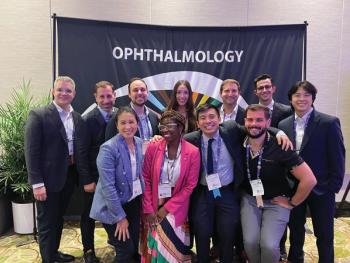
Steven Yeh, MD, shares overview of recent and upcoming presentations
Steven Yeh, MD, discussed his recent presentation at the Retina Society meeting and shared what he is looking forward to presenting at this year's American Academy of Ophthalmology meeting held in Chicago, Illinois.
Steven Yeh, MD, discussed his recent presentation at the Retina Society meeting and shared what he is looking forward to presenting at this year's American Academy of Ophthalmology meeting held in Chicago, Illinois.
Video Transcript:
Editor's note: The below transcript has been lightly edited for clarity.
Sydney M. Crago: Hi. My name is Sydney Crego with Ophthalmology Times and Modern Retina, and I'm here today with Dr Yeh, to talk a little bit about his recent presentations and his upcoming presentations. Dr Yeh, you spoke at the Retina Society Meeting earlier this year. Can you share with the data you presented?
Steven Yeh, MD:Thanks, Sydney. It's great to be here with you today. I had the opportunity to moderate a session on uveitis at the Retina Society in Lisbon, Portugal, and there was 1 paper of particular interest that was presented by Dr Michael Singer. He specifically looked at a clinical registry study that looked at the performance of suprachoroidal triamcinolone acetonide, or XIPERE, for the treatment of macular edema due to non-infectious uveitis over about a 2 year review period. And what they found was that in 750 patients that they evaluated, nearly 800 eyes, patients who received a single dose of XIPERE, less than 5% of these individuals required an injection at the week 10-14 time point. And about 12% of individuals received a supplemental corticosteroid injection at the week 24 time point. This was very consistent with what we saw in the phase 3 PEACHTREE study that looked at XIPERE for the treatment of macular edema due to non-infectious uveitis. It's also notable that he found that about 14% of these patients who were treated had an elevation in their intraocular pressure by 10 millimeters of mercury or more. And this is similar to what was observed in PEACHTREE. About 1 in 7 patients had an elevation in intraocular pressure, and this is particularly important, and that over 40% of individuals in their study there was documented glaucoma by clinical record, suggesting that some of these patients with a history of elevated IOP or even glaucoma could potentially be treated with a low rate of elevation in IOP. And this data really supported the durability and the safety of XIPERE in a real world setting, using this American Academy of Ophthalmology IRIS Registry Database was very exciting to see.
Sydney M. Crago: You are also presenting at the upcoming AAO meeting. Can you share a little bit about the different talks you'll be giving?
Steven Yeh, MD: Well, thanks, Sydney. AAO, is always an exciting time–we're reconnecting with colleagues, we're learning, we're teaching, we're preparing presentations. I'll be presenting on several topics. One is related to a teaching course that's presented by Dr Grant Justin, who organized the course. And I'll be speaking on building sustainable systems with regards to retina health. And specifically related to uveitis and retina care for research in West Africa, which is a program that we've been working on for many years now. In addition, on Sunday, I'll be presenting with the American Uveitis Society, a course entitled Best Practices in Uveitis. I'll be speaking to infectious causes of posterior panuveitis, which can be sight threatening, and it's certainly important to consider for comprehensive ophthalmologists, uveitis, and retina specialists in general.
Sydney M. Crago: Is there anything else you'd like to share about the data or the upcoming presentations?
Steven Yeh, MD: I think that the 2 things that I'd like to share is that you realize that with the infectious uveitis syndromes that we care for, including syphilis and tuberculosis–these certainly have public health impact. But there are other emerging infectious diseases that are on the horizon. Our group has worked specifically with ebola, but there's other outbreaks right now of emerging infectious disease, including Mpox and Marburg virus disease, that can also have ocular complications that are on the horizon that we also need to think about as well. This really is an intersect of worlds of what we can do with innovation and technology to care for not only patients within the United States, but also globally as well. Thanks again, Sydney.
Sydney M. Crago: Thank you so much for your time.
Newsletter
Keep your retina practice on the forefront—subscribe for expert analysis and emerging trends in retinal disease management.












































